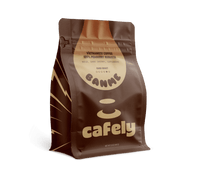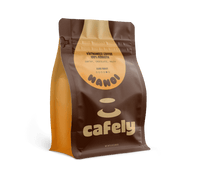Mushroom coffees blend coffee grounds (arabica, robusta, or a blend of both) and functional mushrooms (lion's mane, reishi, chaga, and others). Some versions contain no actual coffee (and, therefore, no caffeine).
Replacing your morning brew with a cup of mushroom coffee provides a range of benefits, from boosted immune function and better digestion to improved cognitive function and reduced stress levels.
There’s no doubt that mushroom coffee offers many more potential health benefits than plain old regular coffee. However, it can taste a little funky, especially if you're not a mushroom lover at heart.
Here are 6 ways to boost the flavor of your mushroom coffee so you can enjoy the benefits these incredible shrooms have to offer.
Cafely Shroom Boost Coffee: Supercharged Brews That Taste Great!
Cafely’s mushroom coffees do all the hard work for you. They provide long-lasting, all-natural energy, various health benefits and taste great right out of the package.
Formulated with over 2 grams of functional mushrooms per serving and 0 grams of sugar!
In this read, we'll be exploring six different ways to make mushroom coffee taste better without ruining the benefits of the fungi or the coffee beans…
Improving the Taste of Mushroom Coffee (6 Tips)

There are several ways to improve the taste of mushroom coffee without reducing its effectiveness. Adjusting the blend to suit your palate is key in creating an enjoyable coffee but you must ensure the ratio is correct if you’re to reap the benefits of the mushrooms.
Let's look at how you can improve the taste of mushroom coffee while retaining its potency:
1. Choose the Right Coffee Base
Selecting a high-quality coffee base that’s intense enough to mask the strong flavors of the mushrooms and enhance their delicate earthy notes is vital.
A dark roast arabica coffee provides complex flavors with sweet, chocolatey notes and woody after tones that are perfect for covering the taste of mushrooms. However, the subtle taste of arabica often allows the earthy taste of mushrooms to reach the front of the palate.
Robusta coffee, although less popular than arabica, is a great choice for making mushroom coffee. This bean has a much stronger flavor, and the bitter, woody notes disguise the taste of the mushrooms well. However, some may find this coffee to be a little too bitter — this can be combated by adding honey or syrup to the brew.
Which type of coffee you use will ultimately depend on your specific taste. Just make sure to go for a coffee with bold, dark flavors.
2. Balance the Mushroom Flavors
Unless you've purchased a high-quality, pre-blended mushroom coffee, you'll need to weigh your coffee and mushroom powders to create a balanced blend that will taste good and prove beneficial.
Mushroom coffee typically consists of a 50:50 blend of mixed functional mushroom powders and ground robusta, arabica, or a blend of both. If you find that a 50:50 ratio is too “mushroomy,” drop the mushroom powders down to 40% and up the coffee to 60%. On the other hand, if the brew is too strong and you want to up your intake of functional mushrooms, up the mushroom powders to 60% and drop the coffee content to 40%.
There are dozens of functional mushroom powders on the market. You will often find pre-blended mushroom coffee powders containing lion’s mane, chaga, reishi, other fungi, and a host of different adaptogens. This makes life easier when it comes to making mushroom coffee. Alternatively, functional mushroom powders can be purchased separately and blended at home.
If you want to create your own blend of functional mushrooms, we recommend using equal parts of at least four of these functional mushroom powders:
- Lion's Mane (Hericium erinaceus)
- Reishi (Ganoderma lucidum)
- Cordyceps (Cordyceps sinensis)
- Chaga (Inonotus obliquus)
- Turkey Tail (Trametes versicolor)
- Tremella (Tremella fuciformis)
- Maitake (Grifola frondosa)
- Shiitake (Lentinus edodes)
- Poria (Poria cocos)
3. Perfect Your Brewing Method
The key to a good cup of coffee is in the brewing. The same goes for mushroom coffee.
There are several ways to brew mushroom coffee, with the French press, Aeropress, and drip filter being the most popular techniques. Whatever method you decide to use to brew your coffee, perfecting it will make the brew taste better.
You don't want to brew mushroom coffee for too long or too short. When using a press, the perfect brew time is usually around five minutes. This ensures a medium to strong coffee is extracted, and the mushrooms have had time to release their beneficial compounds. Brewing for too long can result in a bitter brew with a strong mushroom taste, and not allowing enough brewing time results in a weak coffee with earthy mushroom notes.
4. Add Natural Sweeteners

If you're interested in mushroom coffee, you're probably looking to implement it into your diet to improve your health. Adding refined sugar or artificial sweeteners can definitely improve the flavor of the coffee, but it's not exactly healthy. However, there are other, healthier ways to add a natural sweetness to mushroom coffee.
These natural sweeteners can improve the taste of mushroom coffee:
- Honey
- Maple syrup
- Coconut sugar
- Yacon syrup
- Agave syrup
- Monk fruit
- Stevia
5. Add Cream, Milk, or a Plant-Based Alternative
Adding cream, milk, or a plant-based alternative such as almond or oat milk can improve the taste of mushroom coffee. Making the brew creamier can dull down the earthy tones of the mushrooms and disguise their “funky” taste.
If you usually add milk or homemade creamer to ordinary coffee, you'll enjoy it in a mushroom coffee.
6. Incorporate Spices and Extracts
Incorporating spices and extracts/essences is a great way to adjust the flavor of your coffee and mask the taste of mushrooms. Which spices or extracts work best for you will depend on your taste.
These spices, herbs, and extracts can improve the taste of mushroom coffee:
- Cinnamon
- Cardamom
- Cacao
- Cloves
- Ginger
- Nutmeg
- Vanilla
- Star anise
- Almond
- Coconut
- Peppermint
What is Mushroom Coffee & How Does it Taste?

Mushroom coffee combines functional mushrooms such as lion's mane and reishi with coffee such as arabica or robusta. It provides the potential benefits of both functional mushrooms and high-quality coffee — improved cognitive function, metabolism, and digestion from the mushrooms, as well as increased energy, focus, and concentration from coffee.
Mushroom coffee made from a high-quality mushroom and coffee blend will taste almost identical to a normal cup of coffee. However, you may notice subtle earthy undertones from the mushrooms.
Lower-quality blends can taste pretty bad — they have hollow, bitter, and cheesy elements that don’t make for a very enjoyable cup.
Premium Mushroom Coffee vs. Low-Quality Blends
A high-quality mushroom coffee blend should taste great without needing to add sweeteners, creamers, spices, or syrups.
Premium mushroom coffee blends — such as Cafely’s Shroom Boost Coffees — balance four functional mushrooms (lion's mane, reishi, chaga, and cordyceps) with adaptogens such as rhodiola and ashwagandha to create a blend that compliments and enhances the natural coffee flavor and energizing benefits with less caffeine than a typical cup of coffee.
Lower-quality blends typically take one of two avenues to make their products drinkable:
- They cut out the active ingredients — thus improving the flavor but eliminating the health benefits.
- They pump it full of sugar and artificial sweeteners — again, improving the flavor, but at the cost of its health status.
Premium blends use a clever combination of natural sweeteners, high-grade coffee, and premium mushroom powders to optimize the taste and synergy within the brew.
Making Mushroom Coffee Yourself Can Be Tricky
Making mushroom coffee is a relatively easy process. You simply need to gather a range of dried functional mushrooms and a good coffee bean, grind, and blend. However, creating a blend that tastes good and provides the benefits you're looking for is a delicate task.
Balancing the flavors of the mushrooms and the coffee is no easy feat and requires some level of trial and error. It’s best to experiment with the ratio of mushroom powders to coffee grounds in small amounts. This will allow you to discover a blend that you enjoy without wasting ingredients.
Start with a 50:50 blend of mushroom powders to coffee and adjust it to suit your palate as needed. You may need to add more coffee and reduce the mushroom element or experiment with the ratios of individual mushrooms in the powder itself. Some mushrooms taste more potent than others.
Frequently Asked Questions: Mushroom Coffee
Do you want to learn more about mushroom coffee and the functional mushrooms used in an effective blend?
Read through the answers to the frequently asked questions below or explore our blog:
1. What’s the Best Time of Day to Drink Mushroom Coffee?
Mushroom coffee can be consumed at any time of the day. However, as with any high-caffeine beverage, it's best to avoid drinking mushroom coffee in the evenings as it may affect sleep quality.
Many people like to start their day with mushroom coffee, swapping out their regular morning brew with one that's infused with functional fungi. It provides the energy boost that coffee offers with the added benefits of improved focus and concentration, clear-headedness, and elevated cognitive performance that are associated with functional mushrooms.
Which time of day is “the best” time to drink mushroom coffee ultimately comes down to you as a person. Some find it works best in the mornings, others during the day, and some in the evenings.
Related: Best Time of Day to Drink Coffee.
2. Can Mushroom Coffee Help With Digestion?
Yes, mushroom coffee may help with digestion, as some studies suggest. It contains prebiotics that support gut health, creating a good environment for beneficial gut bacteria to flourish [1]. Mushroom coffee may also help balance the gut's microbiota, which is crucial for a healthy digestive system.
The anti-inflammatory properties of certain functional mushrooms can soothe the digestive tract — reducing discomfort and promoting overall digestive function. Some studies also suggest that mushrooms such as lion’s mane (Hericium erinaceus) reduce symptoms of gastrointestinal disorders such as IBS (irritable bowel syndrome) [2]. These digestive perks are just a few reasons why mushroom coffee is good for you, especially if you're looking to support gut health naturally.
3. What Are the Benefits of Lion's Mane?
Lion's Mane (Hericium erinaceus) is a key functional Mushroom used in most mushroom coffee blends. It boasts a range of health benefits when consumed regularly as a part of a healthy, balanced diet.
The benefits of consuming lion's mane mushrooms include:
- Boosts cognitive function
- Supports nerve growth
- Reduces symptoms of anxiety & depression
- Enhances immune system function
- Anti-inflammatory effects
- Reduces free radicals in the body (high in antioxidants)
- May improve digestive health
- Potentially lowers the risk of heart disease
- Supports overall brain health
- May help manage diabetes
It's important to note that people react differently to functional mushrooms such as lion's mane. You may experience all, some, or none of the benefits mentioned above.
References:
- Balakrishnan, K., Dhanasekaran, D., Krishnaraj, V., Anbukumaran, A., Ramasamy, T., & Manickam, M. (2021). Edible mushrooms: A promising bioresource for prebiotics. In Advances in probiotics (pp. 81-97). Academic Press.
- Gravina, A. G., Pellegrino, R., Auletta, S., Palladino, G., Brandimarte, G., D’Onofrio, R., ... & Federico, A. (2023). Hericium erinaceus, a medicinal fungus with a centuries-old history: Evidence in gastrointestinal diseases. World Journal of Gastroenterology, 29(20), 3048.












